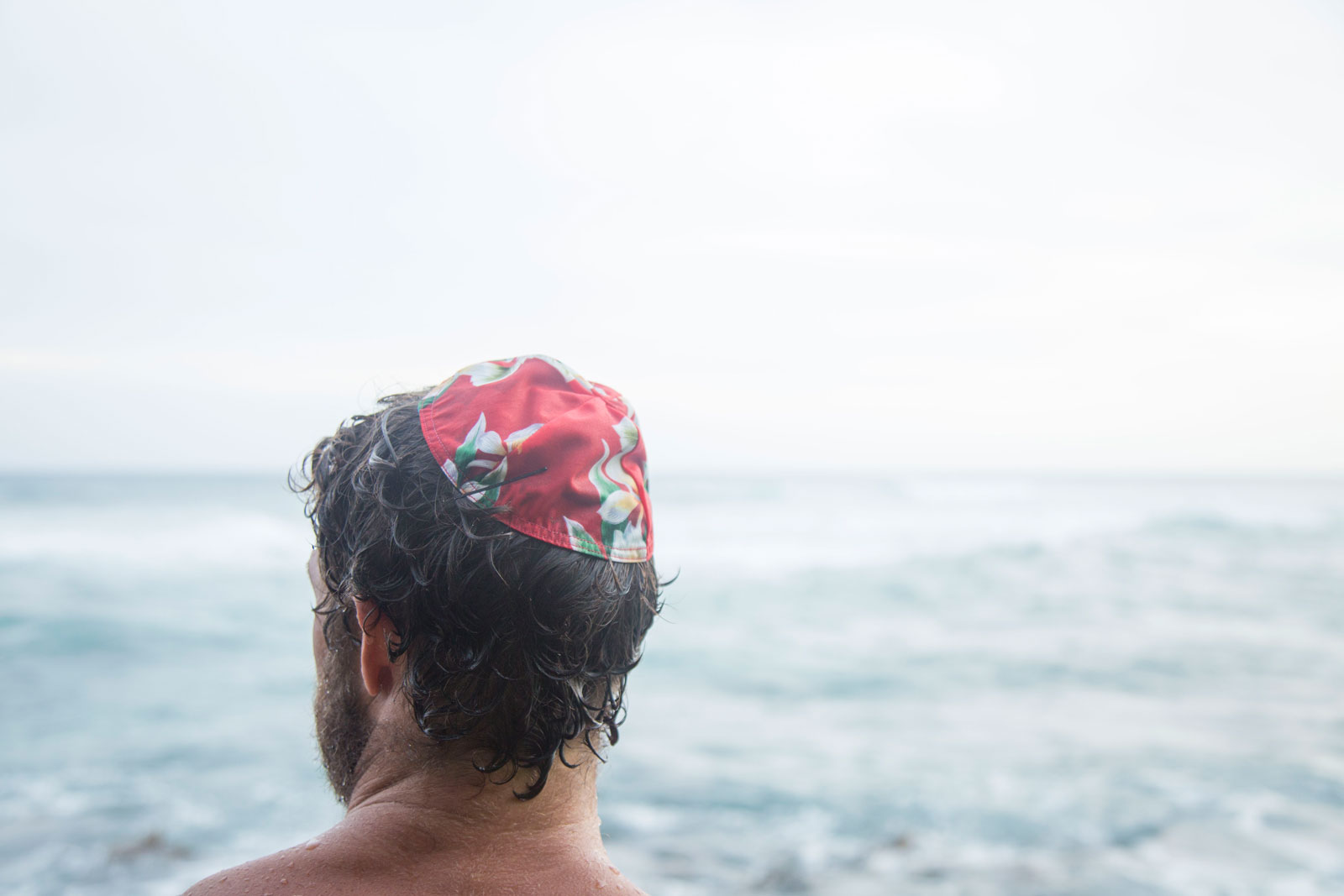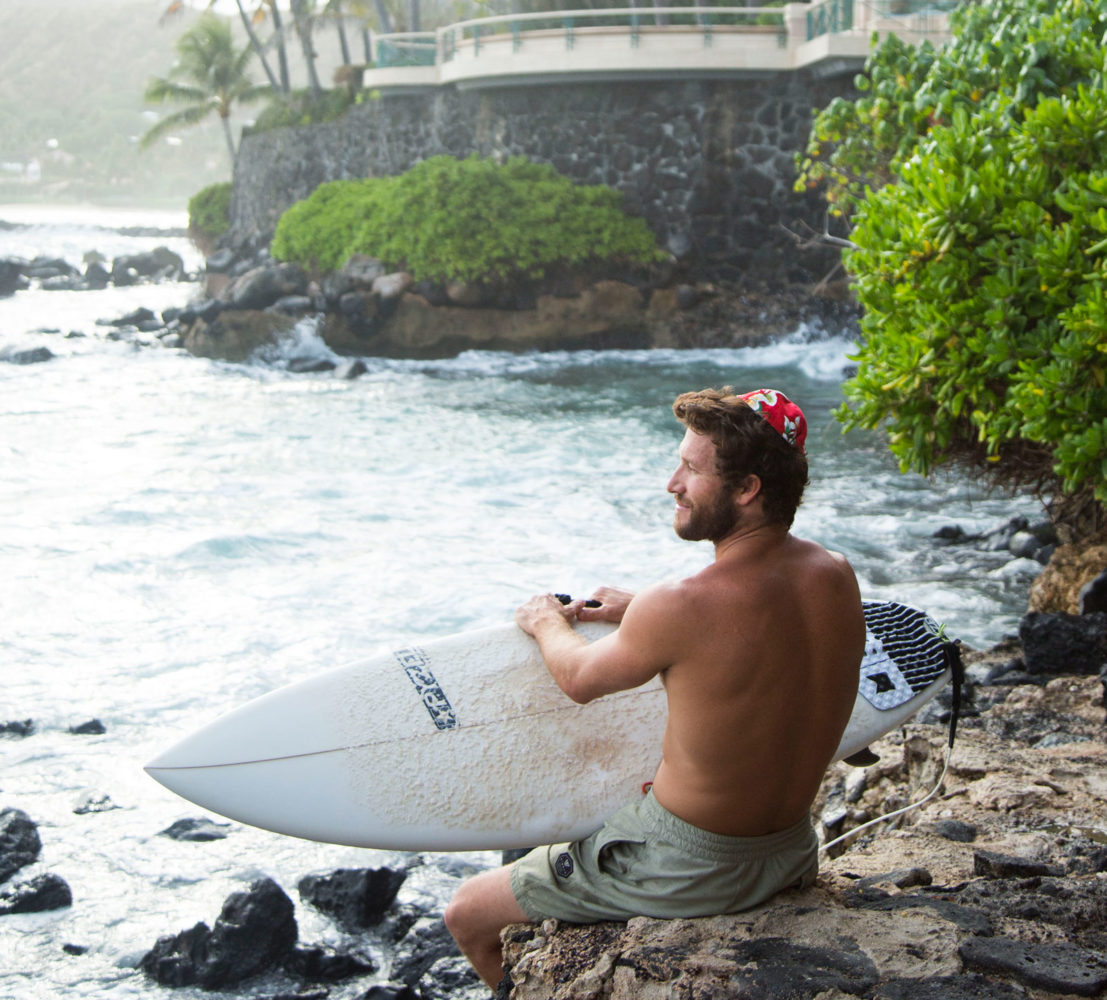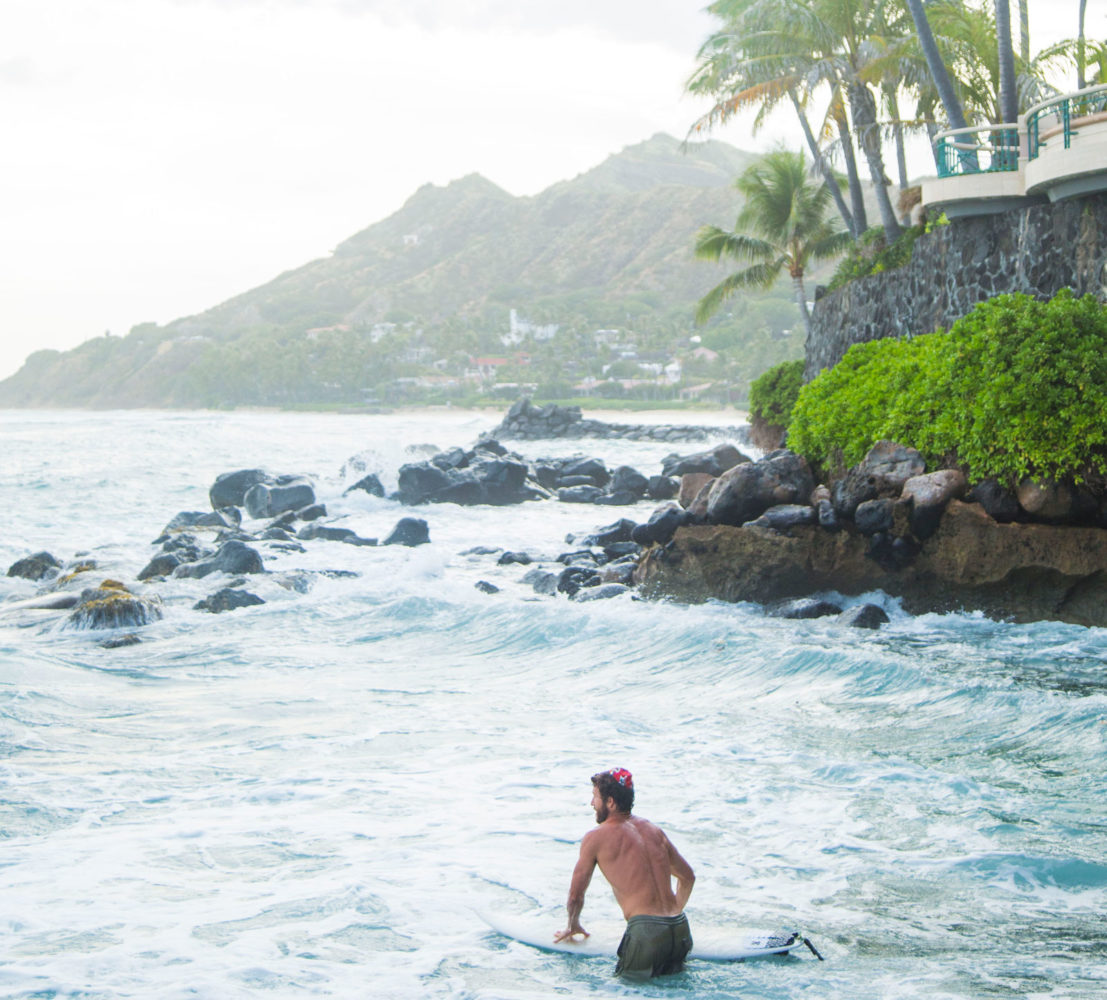Images by Marie Eriel Hobro & John Hook
By all accounts, I’m not the best Jew. I’ve eaten reheated baby back ribs from Outback Steakhouse an hour before going to temple. I’ve never had a bar mitzvah. I married a shiksa (non-Jew). I don’t own a yarmulke, and I don’t know the words to “Hava Nagila.” At barbecues, I pile Redondo’s sausages on the grill next to tri-tip steak next to ʻahi fillets. And that’s not kosher. Literally. But I know that I am a Jew because being Jewish, as much as it is a religion, is an ethnicity. There are names—Stein, Cohen, Weiss, Witz, Levy, Berg—that signify the relatives of our tribe.
As a kid, I knew our people suffered from a long history of persecutions. I knew what the Holocaust was and that it mostly affected us. But most Jews didn’t come to Hawai‘i under duress. Heck, my parents came a few years after the Summer of Love to surf and get weird on Kaua‘i before acting like adults on O‘ahu.
Growing up in Hawaiʻi, I figured I was Jewish because my parents told me so. Not that they were sparkling examples. We didn’t even watch Seinfeld—New York seemed like a different planet compared to O‘ahu. Mom preferred ER when George Clooney was on, and Dad’s pick was the local show Let’s Go Fishing. Hari Kojima was probably the closest thing to a rabbinical figure he ever had.

Perhaps the most Jewish thing I experienced as a child in Hawai‘i—besides the sound of my grandma Janet’s voice (think Kyle’s mom from South Park)—was lighting the menorah each year during Hanukkah. At a Flemister Hanukkah, you lit a candle each night, often forgetting the last two to three evenings, and got increasingly cheaper gifts for eight days in a row. This was mostly because we also celebrated Christmas, placing a Star of David on the top of a Douglas fir. My sister and I always knew Christmas was where the “real” presents were.
While we were told we were Jewish, there was little proof of it. I often wondered what it meant. Was I Jewish because my mom refused to pay full retail? Perhaps I was Jewish because I understood a handful of Yiddish words in the same way our Labrador retriever instinctively doggie-paddled when thrown into the sea. I knew exactly what it meant when my mom said she didn’t want to schlep into town again, or how so-and-so was being a schmuck, or what it meant to nosh or noodge. I intrinsically knew the difference between a mensch and a meshuggener, and to refrain from being the latter. But was that really what it meant to be a Jew? My Japanese friends had bon dance and ramen, my Hawaiian friends had hula and Bruddah Iz, my Korean buds had kimchi and taekwondo. What was our thing? What was our cultural contribution to this bubbling ethnic melting pot? Nobody wants gefilte fish when mahi mahi is on the menu. Even at 10 years old, I knew matzah balls could never outshine malasadas.
I wondered this same question 25 years later. What does it mean to be Jewish—practicing or not—in a remote chain of islands in the middle of the sea? How did other Jews do Jewish here? I would go on my own journey, my own walkabout in the community, to find out. Naturally, I’d have to start with the synagogue.
I slid into Shabbos (common Yiddish for the Jewish Sabbath, or day of rest) at Temple Emanu-El by the skin of my teeth, having been held up by the storm that was dumping rains of Biblical proportions across the state, bringing flashfloods that could certainly hint at the anger of a “greater presence.”
Since the early 1950s, Temple Emanu-El has been a Reform Judaism temple, meaning it is a bit more lax on rules like partitioning men and women during prayer or dress codes. Here, not everything is stringently kosher. It is right off the Pali Highway in Nu‘uanu, just a block from Congregation Sof Ma’arav, a smaller Conservative Judaism group.

“Personally, I look at my Jewish identity as a faith community, much like our other religious neighbors,” said Ken Aronowitz, the rabbi of Temple Emanu-El. “I think looking at Jewishness from an ethnic standpoint doesn’t really lend itself to those that would like to become Jewish by choice. Also, belief in God is not a litmus test for coming through the doors of our temple. It’s not about believing in God or not believing in God, it’s about coming in here and being open to experiencing a greater presence.”
Doing most of the service with a wireless headset microphone and a guitar slung over his shoulder, Aronowitz seemed pretty hip as far as holy men go. It may have been due to the storm, but the assembly was fairly small, consisting of a couple dozen souls alongside a handful of college looky-loos on an excursion for a religion course who you could spot because most congregants were a couple generations older than them. They were welcomed warmly, nonetheless. We sang songs. The vibe felt safe and warm, like most churches do, compounded by the fact that it was thundering outside.
Afterward, I asked the rabbi about connections between Jews and local Hawai‘i culture. What was their figurative addition to these islands’ ethnic plate lunch? He brought up the synagogue’s common greeting, a cute portmanteau combining the Hebrew greeting of shalom and aloha: shaloha. Also, he explained that Temple Emanu-El houses the King Kalākaua Torah Scroll, which was passed to the temple by Princess Abigail Kawānanakoa, passed to her from King David Kalākaua, and was originally given to the king in 1886 for safekeeping by Elias Abraham Rosenberg, a zany Jewish friend and advisor who became known as a kind of royal soothsayer.
Throughout, Aronowitz focused more on the inclusivity of Judaism. “Israel literally translates as, ‘to wrestle with God,’” he said. “So I invite people to get in the ring. I think people search for meaning, and I hope that’s what we offer.”
“Israeli can be a loaded word,” said Moshe Hakemolo, an Israeli Jew who moved to Hawai‘i 20 years ago and now owns Diamond Guy Hawaii, a diamond jewelry business in downtown Honolulu. We met for coffee at Ala Moana. He was dressed brightly, like he was going golfing soon, though I don’t think he was. Like many Israelis I’ve met over the years, Hakemolo had a no-nonsense vibe about him and looked me squarely in the eyes when he spoke.
“I think sometimes when people think of that word [Israeli], they think ‘sharks,’ ‘aggressive,’ ‘harsh,’ ‘business savvy-ness,’ ‘won’t stand in line,’ etcetera,” he said. “But ʻJewish,’ to me, brings a different platter of words. Being Jewish means a deep belief that everything is going to be OK and turn out good in the end. But I see the distinction between the two precisely because I left Israel.”

Like most Israeli men and women, after high school, Hakemolo did mandatory military service in Israel for a couple years. His grandmother was a Holocaust survivor who escaped a Treblinka extermination camp and moved to Israel with her husband in the 1950s with practically nothing. What I’m getting at is that he is made of something harder than an American Jew like me.
Though he assures me that he loves his home country, he likens Israel to a pressure cooker—volatile borders, an expensive cost of living, and increasing traffic—ready to combust. So not long after serving in the army, he moved to Hawai‘i (about as far away from Israel as you can get), opened a business, and started a family. Now he considers Hawai‘i his long-lost home. Not that the transition was easy. Hakemolo admits that at first he couldn’t understand the pace of life here, the slow driving, the food, why everyone was smiling all the time.
“I see it with my mom and other Israelis the first time they come here,” Hakemolo said, smiling. “They don’t get it because they still have ‘Israeli eyes.’ At first they think, as I did, that everything is all wrong because it’s not the same as home. It’s like, if you’re eating spicy all the time and someone gives you candy or something not so harsh tasting, you don’t get it. That’s why I’m so glad to raise my own kids here. It’s easier to find yourself in Hawai‘i, you’re more at ease here than in a place like Israel. At the same time, growing up at home is what gave me my thick skin and made me tough.”
I asked him about any Jewish or Israeli influence he might see making its way into the myriad of cultures here.
“You know, every people has their history of struggle, but,” he says with a pause, before smiling again, “the length and numbers of struggles Jews faced, maybe it’s in our DNA to be the underdogs. So I hope that manifests itself with compassion and sympathy.”
A couple days later, I looked for such a manifestation at a Chabad house in Waikīkī, one of the most remote shuls (synagogues) in the world. Incidentally, it is located at the shuttered Hawaiian Hut nightclub by Ala Moana Hotel. Rabbi Itchel Krasnjansky started the center after moving to Hawai‘i with his wife, Perel, 30 years ago. Chabad, a movement that is part of the Ultra-Orthodox Hasidic faction of lively, mystical Judaism, acts as a type of Jewish Peace Corps, reaching out to Jews all over the world. “In Hawai‘i, many Jewish people have moved here away from structured Jewish life found in bigger cities like, say, New York,” Krasnjansky explained to me before Friday’s Shabbos service. “And some Jews might feel like they’re going through the motions, but not feeling the heart. This Chabad was established as a place where Jews can plug in, learn, and participate.”

Unlike in New York, where it’s easy for Jews to live the Hasidic lifestyle, here in Hawai‘i, “You gotta want it,” Krasnjansky said. “It’s harder to keep Shabbat in a place like this when you might be the only ones doing it. It’s challenging, but I think there’s a deeper appreciation to our traditions that comes with it.”
The Hasidic community here lives with the laws in the Torah as their guidebook. They keep kosher. While it’s not a requirement in coming to the Chabad house, most women here were dressed modestly, in accordance with traditional Jewish law, while the men were dressed like how would you see in certain tightknit New York neighborhoods: black suits, black hats, payot (side curls), tzitzit (dangling waist tassels). However, other visitors wearing aloha shirts didn’t get any side looks. The shul caters to the small community of Hasidic Jews in the state, as well as visiting Jews looking for a kosher Shabbos and place to pray. It also sells aloha-print yarmulkes. And heck yeah, I wore one.
Shabbos at the Chabad house was a different scene than at Temple Emanu-El. The congregation was even smaller, and besides an opening lecture from Krasnjansky in English, most of the service was a collection of ancient hymns, incantations, and rhythms sung in Hebrew. The service was partitioned, with men on one side, women on the other. But it was also a spirited affair. At times, men danced and swayed back and forth while reading aloud from the prayer book, a common physical rev-up (known as shucklen in Yiddish), derived from a passage in the kabalistic literature of the Zohar: “The light [in his soul] is kindled … and he sways to and fro like the flame of a candle.” Sure, I was pretty lost lyrics-wise, but service was no mellow sit-down.
“In the Hasidic community, we have a philosophy,” Krasnjansky said. “One of the cardinal beliefs is, you’ve got to be happy. Philosophically, it’s a joyous approach to serving God and to life in general, and that’s the hallmark of a Hasidic life.”

About 25 years ago, when my childhood friend Keith Kandell—now a successful director and filmmaker—was nearly 13 years old, his parents, trying to give their oldest son some sense of heritage or cultural connection to his Jewish background, asked him if he wanted a bar mitzvah. Keith was into the idea of the ancient coming-of-age ceremony for many Jewish boys and girls during which they read key passages from the Torah and afterward party-hearty, and so a rabbi came over a couple times to study Hebrew with him for the impending big day. Very quickly, Keith started questioning why he was learning a language he would never realistically speak. His parents felt the same way, but still wanted to give him some sort of ritual. So they canceled the rabbi and modified the mitzvah.
In place of Torah scrolls, Keith and his parents handwrote speeches in English. Then, with the speeches stowed in plastic bags plus lei and younger twin brothers (Aaron and Jordan Kandell, screenwriters on Disney’s Moana) in tow, the whole family paddled out on longboards to a lagoon near Diamond Head. They formed a circle and simulated a Hawaiʻi burial-at-sea ceremony, reading the speeches and throwing the strings of lei into the center. Then they rode waves to shore. It was a rite of passage Keith’s father would dub his “surf-mitzvah,” a beautiful blending of ancient customs with a local twist.
Following that watery rite, his parents took him around O‘ahu’s south shore, then up the east side, surfing various spots along the way, until he passed the place of his birth, Kahuku Medical Center. This rite of passage culminated with his first surf session on the North Shore, a kind of Holy Land for surfers. Sure, it might not have resembled a bar mitzvah in a synagogue, and I can’t imagine he was wearing a yarmulke either, but the symbolism wasn’t lost on him.
“Maybe, for me, it’s like that Seinfeld quote, ‘Jewish for the jokes,’” Keith said. “I think as I got into filmmaking, shifting into that world, being Jewish and having the ability to dip into that cultural well of comedy and mishegoss, as we say, there was already a precedent for me. Like, if I find myself on set with Natalie Portman, I can hold my own and make some Jewish jokes or know enough Yiddish, but I also don’t feel terribly defined by it.”
And still, we wondered: What was our visible imprint here in the islands? What were our claims to fame? The Harry and Jeanette Weinberg buildings? Eight years of Linda Lingle? The Kalākaua Torah Scroll?
“That’s kind of the thing about Jews, though, right? It’s more about downplaying it,” Keith said, “not calling a lot of attention to yourself.”
After our conversation, I continued to wonder about my faith. I wondered about the community in Hawai‘i that numbered less than 10,000 people who were somehow relatives of my “tribe.” It began to make sense what identity, what language, what a belief can be when everything has been taken from you and it’s all that you have left. Or I could at least see why it mattered to so many, especially if you come from a people group that has a history of being expelled or exterminated over centuries.
Regardless, I’ve never really been a fan of the church thing. So I went to the only sacred place I knew. The place where I’ve felt the most clarity, where I’ve felt like I belong. The place that’s always felt infinitely greater and more powerful than me, while simultaneously the place where I truly feel like myself: the ocean.
It wasn’t a surf mitzvah per se, but I did paddle out to surf, and it happened to be a Friday. The sun was dipping behind the Waiʻanae Mountain Range, and Shabbos was approaching with the waning light. Maybe I was still doing it wrong, or maybe this was some kind of aquatic synagogue, but I felt at ease by myself, waiting for the next set. I wondered if I happened to be facing Jerusalem, as the good Jews did when they prayed, swaying back and forth like a buoy in high seas. Which way was Jerusalem when you were on the exact other side of the world? Surely, a rabbi would know. As I closed my eyes, swells rolling beneath me, I could feel myself gently tipping to and fro, like my brethren in black hats.



